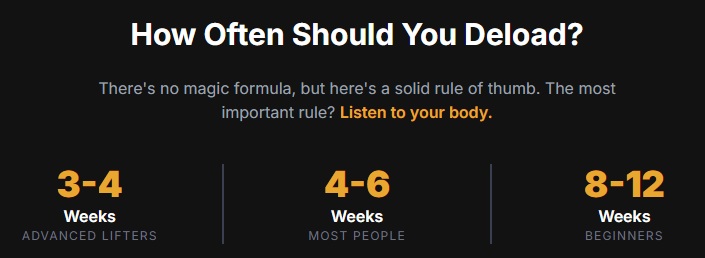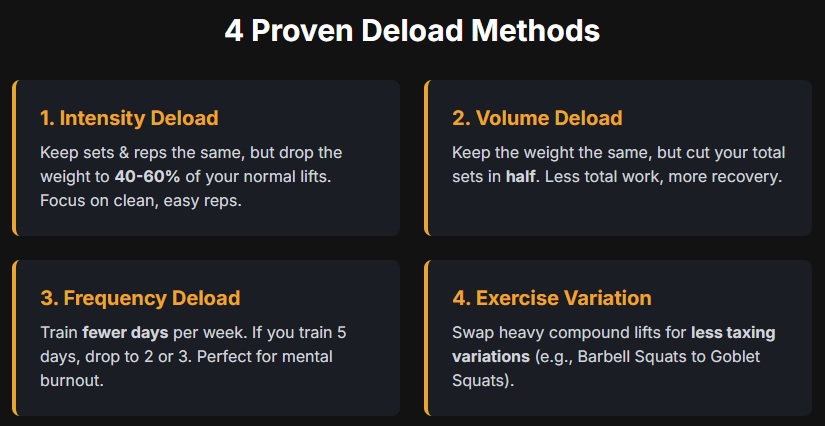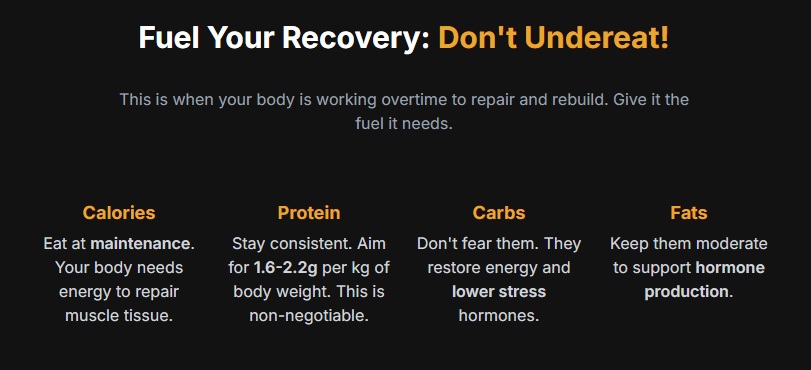Why a Deload Week Is the Most Underrated Shortcut to More Muscle

At first, the idea of backing off for a whole week feels wrong. Like skipping leg day… for seven days straight. I used to think the same — if I wasn’t leaving the gym drenched, it didn’t count. But all that grind caught up with me: sore joints, constant fatigue, no progress. It took me way too long to realize that getting stronger isn’t about crushing yourself every session. Real progress happens when you give your body space to recover and grow. That’s exactly what a deload week does — it’s not weakness, it’s strategy.
Are You Burning Out? Signs You Need a Deload Week Yesterday.
Your body is smarter than your ego. It gives you signs when it’s running on fumes. The problem is, we’re conditioned to ignore them. We call it "the grind." But grinding yourself into dust isn't a badge of honor; it's a one-way ticket to injury and burnout.
Here’s what to look out for:
- Nagging Aches and Pains: that cranky shoulder or tender lower back that just won't go away? That’s not just "part of lifting." It's your body screaming for a break. I learned this the hard way, and it's a story I share in my post about how I finally fixed my own back pain.
- You're Stuck: have you been trying to add another 5kg to your bench press for two months with no luck? When your numbers stop moving up, your central nervous system (CNS) is likely fatigued.
- You Dread Your Workouts: remember when you used to get excited to train? If you now feel a sense of dread or just feel like you're going through the motions, that’s a huge red flag. Your mental energy is just as important as your physical energy.
- You're Always Sore: feeling sore after a tough workout is normal. Feeling like you got hit by a bus for days on end, every single week, is not. Your body isn't recovering.
- Poor Sleep & Irritability: overtraining messes with your hormones, which can wreck your sleep and make you snap at everyone. If you’re feeling extra grumpy, it might not be your boss - it might be your workout schedule.
How Often Should I Do a Deload Week?

Ah, the million-dollar question. The honest answer? It depends. There's no perfect, one-size-fits-all formula. A 22-year-old athlete can handle more than a 45-year-old with a stressful job and three kids.
But here's a solid rule of thumb:
- For most people: plan a deload week every 4-6 weeks of consistent, hard training.
- If you're an advanced lifter pushing serious weight: you might need one every 3-4 weeks.
- If you're a beginner or your training isn't super intense: you might be able to go 8-12 weeks.
The most important thing is to stop looking at the calendar and start listening to your body. If you’re ticking off the boxes from the list above, it’s time. Don't wait for the schedule to tell you. Your body already is.
How to Deload Correctly (Four Proven Deload Methods)

There’s more than one way to give your body a break without losing your momentum. The key is to stay active, but reduce the overall stress on your body. Below are four tried-and-true methods athletes use to deload effectively. You can mix and match depending on how your body feels and what kind of fatigue you’re dealing with.
- Intensity Deload (Weight Reduction): Keep your sets and reps the same, but drop the weight on the bar to about 40–60% of what you normally lift. For example, if you bench 100 kg for 3 × 8, do 50 kg for 3 × 8. The movement should feel smooth and easy. No grinding, no failure — just clean reps to keep the pattern fresh while your body recovers.
- Volume Deload (Set Reduction): Keep your usual training weights, but cut your total sets in half. If you normally do four sets of squats, just do two. Same reps, less total work. You’ll finish faster, stay active, and still allow your muscles to recover from accumulated fatigue.
- Frequency Deload (Fewer Sessions): Sometimes your body isn’t the only thing tired — your mind is, too. In that case, simply reduce how many days you train. If you usually train five days a week, try two or three. Keep the same exercises and intensity, but enjoy more rest days. This is perfect for athletes dealing with burnout or high life stress.
- Exercise Variation Deload (Less Taxing Lifts): Another great option is to swap out your heavy compound lifts for lighter, easier variations. Replace barbell back squats with goblet squats, or conventional deadlifts with Romanian dumbbell deadlifts. You’ll maintain the movement pattern but massively reduce the systemic load, giving your joints and nervous system a break.
During this week, focus on recovery work you often skip — mobility, stretching, or light cardio. A proper stretching routine for bodybuilders can do wonders when your body isn’t drained from intense training. Think of this as hitting the “reset” button — staying active, but letting your body catch up and rebuild stronger.
What to Eat During a Deload Week

Most people make the same mistake during a deload: they stop training hard and start eating like a bird. Big mistake. Because this is the week when your body is working overtime to repair and rebuild the microdamage you’ve accumulated in previous workouts. Recovery isn’t a passive process — it’s hard work that demands energy and nutrients.
Think of it this way: if training breaks your muscles down, recovery is the construction phase. You wouldn’t tell the builders to show up without bricks, would you? Your job this week is to supply the materials — calories, protein, and micronutrients — so the rebuild can actually happen. But don't get me wrong: i didn't say you have to eat your weekly intake in one day.
- Calories: keep your intake around maintenance. Don’t try to cut — your body needs fuel to repair muscle tissue and replenish glycogen. Undereating will just make you feel flat and sluggish.
- Protein: stay consistent. Protein is still your number one recovery nutrient. Aim for 1.6–2.2 grams per kilogram of body weight daily. Those amino acids are literally the raw materials for muscle repair.
- Carbs: don’t fear them. They restore your energy stores and help lower cortisol, your stress hormone. Stable carbs mean better sleep and recovery.
- Fats: keep them moderate. Healthy fats support hormone production — especially testosterone — which dips when you’re chronically underfed.
In short: you’re not eating less because you’re lazy this week — you’re eating smart because your body is rebuilding. Treat food as recovery fuel, not a reward for hard training. If you want a ready-to-use plan that fits perfectly with this philosophy, grab this 7-day muscle building diet plan.
Remember, a deload isn’t backing off — it’s recharging. You can’t pour from an empty tank, and you can’t rebuild muscle without proper fuel. Eat, rest, recover — and come back sharper, stronger, and hungrier for progress.
What to Expect After a Deload
So, you’ve done your deload week right — you trained lighter, slept more, ate well, and maybe even enjoyed not living under a barbell for a few days. What now? This is where you cash in on all that recovery.
Physically, you’ll notice it almost immediately. Your body feels fresher. The nagging aches in your shoulders and knees? Faded. Muscles that used to feel tight or heavy now feel alive again. You’ll move better, lift smoother, and your energy levels will feel like they’ve been reset.
Mentally, the difference can be even more powerful. The fatigue, the burnout, the quiet dread before leg day — gone. Instead, you’ll feel a spark again. Motivation comes back naturally, and training feels exciting instead of like another task to survive.
How to return to training: Don’t go from zero to hero overnight. Ease back into your program. During your first week back, work at roughly 90% of your usual loads or intensity. This gives your nervous system time to readjust to heavy lifting without shocking your body. After a few sessions, you’ll find your strength not only returns but often surpasses your previous bests.
The payoff of a smart deload isn’t just feeling good for a few days — it’s setting up the next wave of progress. So treat your deload like a strategic pause, not a step back. Recharge, refocus, and then go crush it.
FAQ
- What is a deload week?
- A deload week is a strategic, planned week of reduced training intensity and/or volume. It's not about being lazy; it's a form of active recovery that gives your body, joints, and central nervous system a chance to heal from accumulated fatigue, helping you prevent burnout and come back stronger.
- How do I know if I need a deload week?
- Your body provides clear signs. You likely need a deload if you're experiencing nagging aches and pains, have hit a strength plateau, feel a sense of dread before workouts, are constantly sore, or suffer from poor sleep and irritability.
- How often should I deload?
- While it depends on your training intensity and experience, a general guideline is to plan a deload every 4-6 weeks. Advanced athletes might need one every 3-4 weeks, while beginners may only need one every 8-12 weeks. The most important rule is to listen to your body's feedback.
- Should I eat less during a deload week?
- No, this is a common mistake. You should eat at your maintenance calorie level. Your body is in a heavy repair and rebuilding phase, and it needs fuel. Keep protein intake high (1.6-2.2g per kg of body weight) and include sufficient carbs to replenish glycogen and lower stress hormones.
- What are the best ways to deload?
- There are four main methods: 1) Reduce intensity by lifting only 40-60% of your usual weight. 2) Reduce volume by cutting your total sets in half. 3) Reduce frequency by training fewer days per week. 4) Use less taxing exercise variations, like swapping barbell squats for goblet squats.
- How should I return to training after a deload?
- Ease back into your routine. For the first week back, train at about 90% of your usual intensity or weight. This allows your nervous system to readjust to the heavy load without shock, often leading to new strength gains shortly after.